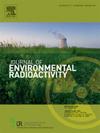Characterizing major and trace element concentrations, and radioactivity in bulk glass samples from the trinity atomic test
IF 1.9
3区 环境科学与生态学
Q3 ENVIRONMENTAL SCIENCES
引用次数: 0
Abstract
Glass fragments (16 green glasses and 2 red glasses) were handpicked from crushed Trinitite. X-ray diffraction studies revealed that these samples were essentially pure glass with the exception of minor amounts (less than 4 wt%) of quartz (which acts as a diluent) in some samples. The concentrations of 45 elements in the Trinity glasses were determined using Instrumental Neutron Activation Analysis. Plutonium-239 concentrations were determined by measuring the activity of fission products produced during thermal neutron irradiation of the glasses. The activity of various radionuclides was determined by gamma ray spectroscopy. Elemental concentrations were also determined for 12 arkosic sand samples from the Trinity site. The Trinity glasses are essentially a mixture of arkosic sand, radionuclides and elements from the atomic device, and elements associated with the structures in the immediate vicinity of the test site. Comparison of glass chemistry to the arkosic sand chemistry allows an assessment to be made of the addition and removal of various elements during glass formation.
Ba-133 and Cs-137 are linearly related to the Pu-239 + U-235device content of the glasses. Barium (Baratrol) was used in the device and Ba-133 activity has a positive y-intercept, which suggests that some of the Ba-133 activity may be due to activation of Ba in the arkosic sands. For Cs-137, the y-intercept is negative which suggests a depletion of Cs-137 in the glasses. The present-day Am-241 activity shows a linear relationship with Pu-239 activity (r2 = 0.99). Am-241 is derived via beta decay of Pu-241, and the Pu-241/Pu-239 activity ratio can be used to distinguish different Pu sources. For the Trinity glasses, this ratio is 0.70 ± 0.16.
Relative to the arkosic sand elemental concentrations, the glasses are depleted in As, Br, Cs, Sb, Se, and Zn presumably because of their relatively high volatility. The depletion of several other elements (Co, Ir, Mg, Ni, V, W) may be due to their removal by metallic droplets during glass formation. Relative enrichment of U, Mo, Ti, and Ba is due to addition of these elements from the atomic device and associated structures.
The residual activity of Eu-152 is used to determine the distance of individual glass samples from ground zero. Most of the samples fall between 40 and 50 m (near the edge of the glass free crater formed during the atomic explosion). Similar results were obtained for a different batch of samples using residual Co-60 activity. The inference is that the material that comprises the bulk of the glass originated close to ground zero and was distributed across the site as an ejection blanket. Material from the atomic bomb was added during the formation of this ejection blanket.
三位一体原子试验中大块玻璃样品的主要和微量元素浓度及放射性特征。
玻璃碎片(16个绿色玻璃杯和2个红色玻璃杯)是从粉碎的三位一体中精心挑选出来的。x射线衍射研究表明,这些样品基本上是纯玻璃,除了少量(小于4 wt%)的石英(作为稀释剂)在一些样品中。用仪器中子活化分析法测定了三位一体玻璃中45种元素的浓度。钚-239的浓度是通过测量玻璃在热中子辐照过程中产生的裂变产物的活性来确定的。用伽马射线能谱法测定了各种放射性核素的活度。元素浓度也测定了12个黑砂岩样品从三一基地。三位一体玻璃本质上是黑砂、放射性核素和原子装置的元素,以及与试验场附近结构有关的元素的混合物。将玻璃化学与黑砂岩化学进行比较,可以对玻璃形成过程中各种元素的添加和去除进行评估。Ba-133和Cs-137与玻璃中Pu-239 + u- 235器件的含量呈线性相关。该装置使用钡(Baratrol), Ba-133活性具有正的y截距,这表明部分Ba-133活性可能是由于黑砂岩中Ba的活化。对于Cs-137, y截距是负的,这表明玻璃杯中Cs-137的损耗。现今Am-241活度与Pu-239活度呈线性关系(r2 = 0.99)。Am-241是通过Pu-241的β衰变得到的,Pu-241/Pu-239的活度比可以用来区分不同的Pu源。对于Trinity玻璃,这个比值是0.70±0.16。相对于黑砂岩元素浓度,玻璃中As、Br、Cs、Sb、Se和Zn的含量较低,可能是由于它们相对较高的挥发性。其他几种元素(Co, Ir, Mg, Ni, V, W)的损耗可能是由于它们在玻璃形成过程中被金属液滴除去。U, Mo, Ti和Ba的相对富集是由于原子装置和相关结构中添加了这些元素。Eu-152的残余活度用于确定单个玻璃样品与地面零点的距离。大多数样品落在40到50米之间(靠近原子爆炸期间形成的无玻璃陨石坑的边缘)。使用剩余Co-60活性对不同批次的样品获得了类似的结果。由此推断,构成大部分玻璃的材料起源于地面零点附近,并作为弹射毯分布在整个场地。在这个弹射层的形成过程中加入了原子弹的物质。
本文章由计算机程序翻译,如有差异,请以英文原文为准。
求助全文
约1分钟内获得全文
求助全文
来源期刊

Journal of environmental radioactivity
环境科学-环境科学
CiteScore
4.70
自引率
13.00%
发文量
209
审稿时长
73 days
期刊介绍:
The Journal of Environmental Radioactivity provides a coherent international forum for publication of original research or review papers on any aspect of the occurrence of radioactivity in natural systems.
Relevant subject areas range from applications of environmental radionuclides as mechanistic or timescale tracers of natural processes to assessments of the radioecological or radiological effects of ambient radioactivity. Papers deal with naturally occurring nuclides or with those created and released by man through nuclear weapons manufacture and testing, energy production, fuel-cycle technology, etc. Reports on radioactivity in the oceans, sediments, rivers, lakes, groundwaters, soils, atmosphere and all divisions of the biosphere are welcomed, but these should not simply be of a monitoring nature unless the data are particularly innovative.
 求助内容:
求助内容: 应助结果提醒方式:
应助结果提醒方式:


